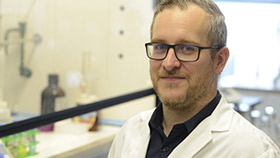How Does the HIV Reservoir Avoid Destruction?
Researchers define new ways HIV-infected cells evade targeted attacks
By Jeffrey Laurence, M.D.
Research question
Cooperation between antibodies and immune cells leads to a potent defense against infection known as antibody-dependent cellular cytotoxicity, or ADCC. ADCC appears to be an important component of the immune system’s attempts to suppress HIV reservoirs, whose persistence despite antiretroviral therapy is the main barrier to a cure.
However, the susceptibility of HIV-infected cells to ADCC depends on two key factors. One is the amount and type of expression of HIV envelope proteins on the cell surface. (This is the focus of other research by amfAR-funded scientists seeking to design anti-HIV antibodies better able to facilitate recognition of diverse envelope structures.) The second is the presence of specific receptors on the immune system’s natural killer (NK) cells. Evidence from prior studies suggests that HIV can evade the latter, but the mechanisms by which this happens remain unclear.

Findings
Scientists from Canada, Germany, and the University of Pennsylvania who collaborated on this project have now shed light on how HIV evades NK cells. They recognized that Vpu, a protein encoded by HIV-1, can suppress formation of one such NK cell receptor, NTB-A. But other receptors might assume its function. They now report that Vpu can also inhibit another important ADCC interacting protein, CD48, on the surface of infected cells.
Impact
The authors conclude that such “understanding of the mechanisms used by HIV-1 to evade ADCC might help develop novel approaches to reduce the viral reservoirs.”
amfAR’s role
amfAR was a funder of this research. One of the authors of the study, Dr. Jonathan Richard, of the Université de Montréal, Centre de Recherche du CHUM, is an amfAR grantee.
Original article
http://www.ncbi.nlm.nih.gov/pubmed/37404017
Dr. Laurence is amfAR’s senior scientific consultant.
Share This:
